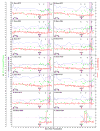Immune suppression of challenged vaccinates as a rigorous assessment of sterile protection by lentiviral vaccines
- PMID: 17023099
- PMCID: PMC1855206
- DOI: 10.1016/j.vaccine.2006.09.040
Immune suppression of challenged vaccinates as a rigorous assessment of sterile protection by lentiviral vaccines
Abstract
We previously reported that an experimental live-attenuated equine infectious anemia virus (EIAV) vaccine, containing a mutated S2 accessory gene, provided protection from disease and detectable infection after virulent virus (EIAV(PV)) challenge [Li F, Craigo JK, Howe L, Steckbeck JD, Cook S, Issel C, et al. A live-attenuated equine infectious anemia virus proviral vaccine with a modified S2 gene provides protection from detectable infection by intravenous virulent virus challenge of experimentally inoculated horses. J Virol 2003;77(13):7244-53; Craigo JK, Li F, Steckbeck JD, Durkin S, Howe L, Cook SJ, et al. Discerning an effective balance between equine infectious anemia virus attenuation and vaccine efficacy. J Virol 2005;79(5):2666-77]. To determine if attenuated EIAV vaccines actually prevent persistent infection by challenge virus, we employed a 14-day dexamethasone treatment of vaccinated horses post-challenge to suppress host immunity and amplify replication levels of any infecting EIAV. At 2 months post-challenge the horses were all protected from virulent-virus challenge, evidenced by a lack of EIA signs and detectable challenge plasma viral RNA. Upon immune suppression, 6/12 horses displayed clinical EIA. Post-immune suppression characterizations demonstrated that the attenuated vaccine evidently prevented detectable challenge virus infection in 50% of horses. These data highlight the utility of post-challenge immune suppression for evaluating persistent viral vaccine protective efficacy.
Figures


 , right Y axis) and platelet counts (
, right Y axis) and platelet counts (
 , first left Y axis) were followed daily for up to 300 days (X-axis) after the first vaccine dose. Quantification of the virus load (
, first left Y axis) were followed daily for up to 300 days (X-axis) after the first vaccine dose. Quantification of the virus load (
 , second left Y axis) was performed on viral RNA extracted from plasma at periodic time points prior to and after virulent virus challenge using the LDME protocol (DOC,↓↓↓). The period of dexamethasone-induced immune suppression is demarcated by a pink shaded box. Two naïve control animals (Panels M-N) were also challenged with the LDME protocol (DOC,↓↓↓). Febrile episodes were defined by a rectal temperature above 39°C (
, second left Y axis) was performed on viral RNA extracted from plasma at periodic time points prior to and after virulent virus challenge using the LDME protocol (DOC,↓↓↓). The period of dexamethasone-induced immune suppression is demarcated by a pink shaded box. Two naïve control animals (Panels M-N) were also challenged with the LDME protocol (DOC,↓↓↓). Febrile episodes were defined by a rectal temperature above 39°C (
 ) in conjunction with thrombocytopenia (platelets ≤100,000/μl of whole blood) and other clinical symptoms of EIA. S2 diagnostic results for each animal are indicated in each respective panel above the date of analysis by either a V (vaccine strain) or a C (challenge strain).
) in conjunction with thrombocytopenia (platelets ≤100,000/μl of whole blood) and other clinical symptoms of EIA. S2 diagnostic results for each animal are indicated in each respective panel above the date of analysis by either a V (vaccine strain) or a C (challenge strain).

 ).
).
Similar articles
-
Discerning an effective balance between equine infectious anemia virus attenuation and vaccine efficacy.J Virol. 2005 Mar;79(5):2666-77. doi: 10.1128/JVI.79.5.2666-2677.2005. J Virol. 2005. PMID: 15708986 Free PMC article.
-
A live attenuated equine infectious anemia virus proviral vaccine with a modified S2 gene provides protection from detectable infection by intravenous virulent virus challenge of experimentally inoculated horses.J Virol. 2003 Jul;77(13):7244-53. doi: 10.1128/jvi.77.13.7244-7253.2003. J Virol. 2003. PMID: 12805423 Free PMC article.
-
Serological method using recombinant S2 protein to differentiate equine infectious anemia virus (EIAV)-infected and EIAV-vaccinated horses.Clin Diagn Lab Immunol. 2004 Nov;11(6):1120-9. doi: 10.1128/CDLI.11.6.1120-1129.2004. Clin Diagn Lab Immunol. 2004. PMID: 15539516 Free PMC article.
-
Cytotoxic T lymphocytes in protection against equine infectious anemia virus.Anim Health Res Rev. 2004 Dec;5(2):271-6. doi: 10.1079/ahr200482. Anim Health Res Rev. 2004. PMID: 15984338 Review.
-
Review and future perspectives on the integration characteristics for equine lentivirus in the host genome.Pol J Vet Sci. 2023 Mar;26(1):163-172. doi: 10.24425/pjvs.2023.145019. Pol J Vet Sci. 2023. PMID: 36961267 Review.
Cited by
-
Broader HIV-1 neutralizing antibody responses induced by envelope glycoprotein mutants based on the EIAV attenuated vaccine.Retrovirology. 2010 Sep 1;7:71. doi: 10.1186/1742-4690-7-71. Retrovirology. 2010. PMID: 20807451 Free PMC article.
-
Development of a high throughput, semi-automated, infectious center cell-based ELISA for equine infectious anemia virus.J Virol Methods. 2012 Nov;185(2):221-7. doi: 10.1016/j.jviromet.2012.07.007. Epub 2012 Jul 20. J Virol Methods. 2012. PMID: 22820072 Free PMC article.
-
Prospects in Innate Immune Responses as Potential Control Strategies against Non-Primate Lentiviruses.Viruses. 2018 Aug 17;10(8):435. doi: 10.3390/v10080435. Viruses. 2018. PMID: 30126090 Free PMC article. Review.
-
Protective efficacy of centralized and polyvalent envelope immunogens in an attenuated equine lentivirus vaccine.PLoS Pathog. 2015 Jan 8;11(1):e1004610. doi: 10.1371/journal.ppat.1004610. eCollection 2015 Jan. PLoS Pathog. 2015. PMID: 25569288 Free PMC article.
-
Challenges and proposed solutions for more accurate serological diagnosis of equine infectious anaemia.Vet Rec. 2013 Feb 23;172(8):210. doi: 10.1136/vr-2012-100735. Epub 2012 Nov 16. Vet Rec. 2013. PMID: 23161812 Free PMC article.
References
-
- Li F, Craigo JK, Howe L, Steckbeck JD, Cook S, Issel C, et al. A Live Attenuated Equine Infectious Anemia Virus Proviral Vaccine with a Modified S2 Gene Provides Protection from Detectable Infection by Intravenous Virulent Virus Challenge of Experimentally Inoculated Horses. The Journal of Virology. 2003;77(13):7244–7253. - PMC - PubMed
-
- Mims CA. The Pathogenesis of Infectious Diseases. 3. SanDiego: Academic; 1987.
-
- Melink JA. Vaccines. 2. SanDiego: Academic; 1994.
-
- Baba TW, Liska V, Khimani AH, Ray NB, Dailey PJ, Penninck D, et al. Live attenuated, multiply deleted simian immunodeficiency virus causes AIDS in infant and adult macaques. Nat Med. 1999;5:194–203. - PubMed
Publication types
MeSH terms
Substances
Grants and funding
LinkOut - more resources
Full Text Sources

